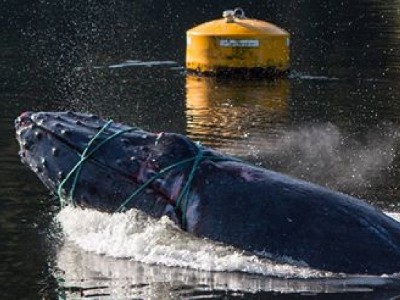

In a complicated six-hour rescue, an entangled juvenile humpback whale was earlier this week freed from aquaculture lines near Klemtu, BC., with officials stating that they are more and more having to perform such rescues of entangled whales. The near-tragedy highlights a growing danger faced by humpback populations around the world, even as the U.S. National Oceanic and Atmospheric Administration (NOAA) has just lifted its endangered species designation for most humpback populations.
The ten-metre whale was spotted on Monday morning in obvious distress, thrashing around violently with several ropes cutting into its flesh, bringing local and federal fisheries officers to the scene who together with members of the Kitasoo First Nation and employees from the Marine Harvest aquaculture company spent six hours working on freeing the animal, a delicate process, says Paul Cottrell, marine coordinator with the Department of Fisheries and Oceans. “It was a very difficult entanglement. One wrong cut and we could leave gear on the animal that could be lethal,” says Cottrell who confirmed that they were “cautiously optimistic” that the juvenile humpback, which was estimated to be under three years of age, would recover from the injuries suffered during the struggle. “We’re going to monitor this animal,” Cottrell stated.
Marine Harvest says that the entanglement is a first for the company and that they plan to review the anchoring design for their aquaculture sites to see if any changes are necessary to prevent it from happening again.
But with the recent upswing in the humpback population along BC’s coast, experts say that they are seeing more and more whales becoming entangled in fishing lines. “Our preliminary results from research conducted with MERS (Marine Education Research Society)/DFO suggest that over 47 per cent of Humpbacks in B.C. have been entangled,” says Jackie Hildering, Education and Communications Director with MERS, who says that people who find an entangled whale should immediately report it to the DFO Incident Reporting Line.
Last week the NOAA removed most of the world’s humpback whale populations from its endangered species list by effectively dividing up the species into 14 separate populations and declaring nine of these to be no longer endangered, leaving five others still designated as endangered. The move that has drawn criticism for being trumpeted as a “success story” for humpbacks in general, all the while downplaying the plight of the species in some regions. “The plan may be a win for some populations, but for others, it is grossly inept,” says Regina Asmutis-Silvia, cetacean biologist with Whale.org in Plymouth, Massachusetts, who contends that ship strikes and entanglements are increasingly becoming threats to humpback populations.
The Canadian Committee on the Status of Endangered Wildlife is reported to be in the midst of its own downgrade of humpbacks from threatened species to species of special concern. Andrew Trites, director of the Marine Mammal Research Unit at the University of British Columbia has stated in conversation with the CBC that, “Overall, it’s a very good news story of what can be done when a species is protected,” yet adds that the humpbacks found in BC’s Strait of Georgia and Salish Sea are most often from weaker populations, such as that based in Mexico (now downgraded to “threatened” status by the NOAA) or Central America (one of the four to remain on the NOAA’s endangered species list).
Leave a Reply
You must be logged in to post a comment.



 Share
Share Tweet
Tweet Share
Share




Comment